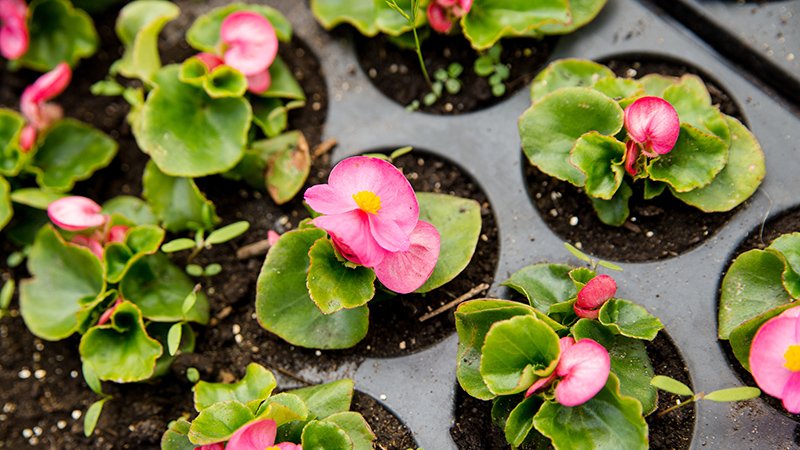Ways the Impressive Capability of ChatGPT Might Impact the Horticulture Industry
It seemed like my news feed was recently full of stories about chatGPT. But, like many, I was too busy with other activities and responsibilities to really dig into what it was and why seemingly everyone was writing about it. That is, until I had lunch with my friend Jason Smith, a partner at CF Financial, who told me about his experience of using chatGPT as an additional tool for brainstorming and augmenting research work as he supports clients, some of which are growers. That got my attention, and I started researching and experimenting with the truly fascinating tool called chatGPT.
What Is chatGPT?
ChatGPT is a new chatbot, which Wikipedia defines as “a software application used to conduct an online chat conversation via text or text-to-speech, in lieu of providing direct contact with a live human agent.”
ChatGPT can answer questions and participate in very human-like dialog across a full spectrum of information and topics, even able to refer to previously produced answers and expound upon them.
ChatGPT is powered by a collection of advanced artificial intelligence technologies such as GPT-3 and deep learning. GPT-3 is a special type of artificial intelligence language model that can generate textual responses to prompts or questions which Wikipedia describes like this: “The quality of the text generated by GPT-3 is so high that it can be difficult to determine whether or not it was written by a human, which has both benefits and risks.”
ChatGPT comes from OpenAI, an organization that ‘conducts fundamental, long-term research toward the creation of safe Artificial General Intelligence (AGI)’.
OpenAI introduces chatGPT this way: “We’ve trained a model called ChatGPT which interacts in a conversational way. The dialogue format makes it possible for ChatGPT to answer follow up questions, admit its mistakes, challenge incorrect premises, and reject inappropriate requests.”
Nisha Arya, writing for KDnuggets, a leading site on data science, machine learning and artificial intelligence and analytics, says “ChatGPT is an AI-based chatbot system which OpenAI launched in November 2022. OpenAI is known for creating Whisper, an automatic speech recognition system and DALLE•2, an AI image and art generator.”
What Can chatGPT do Now?
It can answer questions and participate in dialog.
ChatGPT can have a conversation with you, answering questions and it will respond to additional questions about previous answers.
In the following image, I asked chatGPT a simple question from elementary geometry: How do you calculate the area of a circle? Then I asked follow-up question referring to what it had just replied about the diameter.
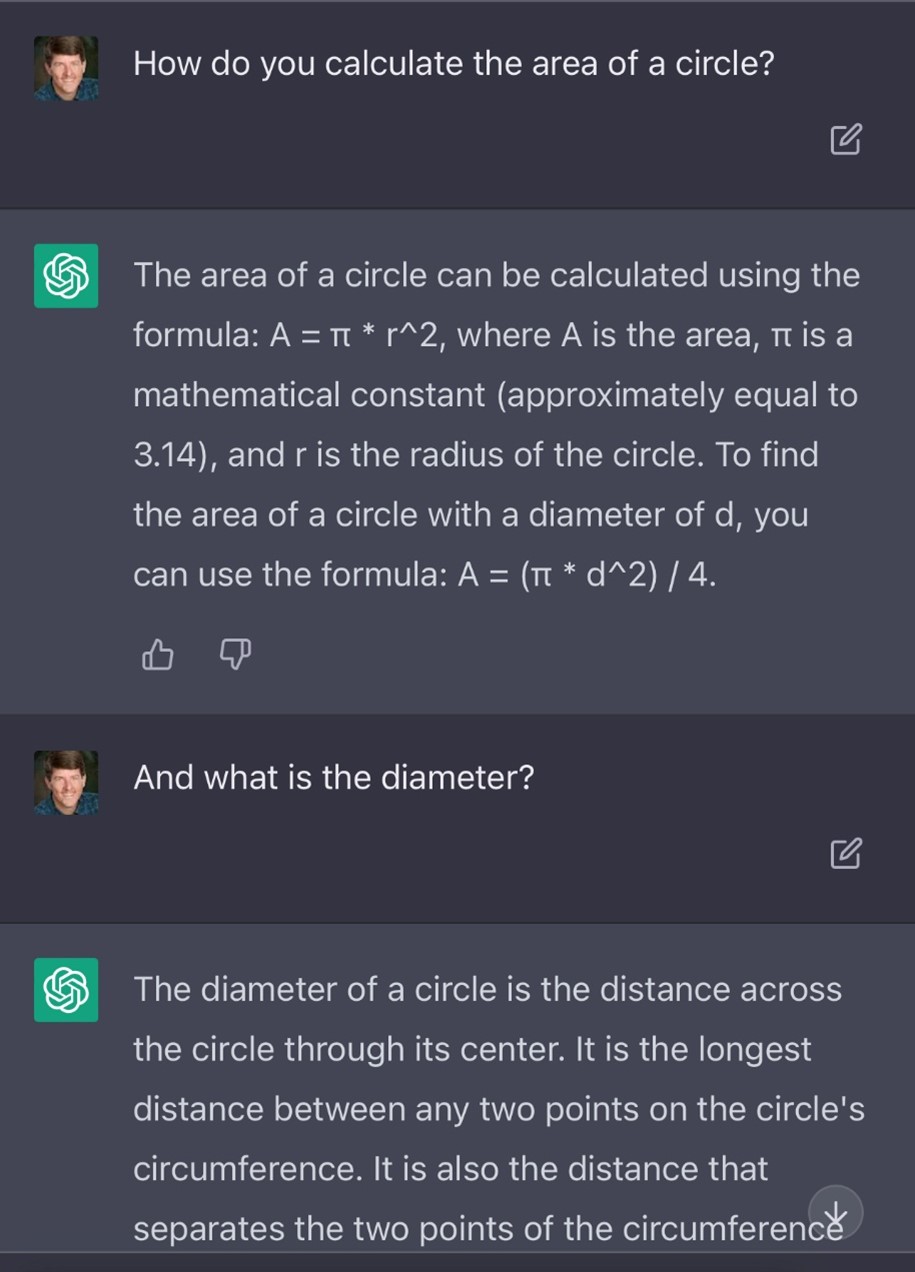
I also asked ChatGPT various questions about history like the following question about Napoleon Bonaparte:
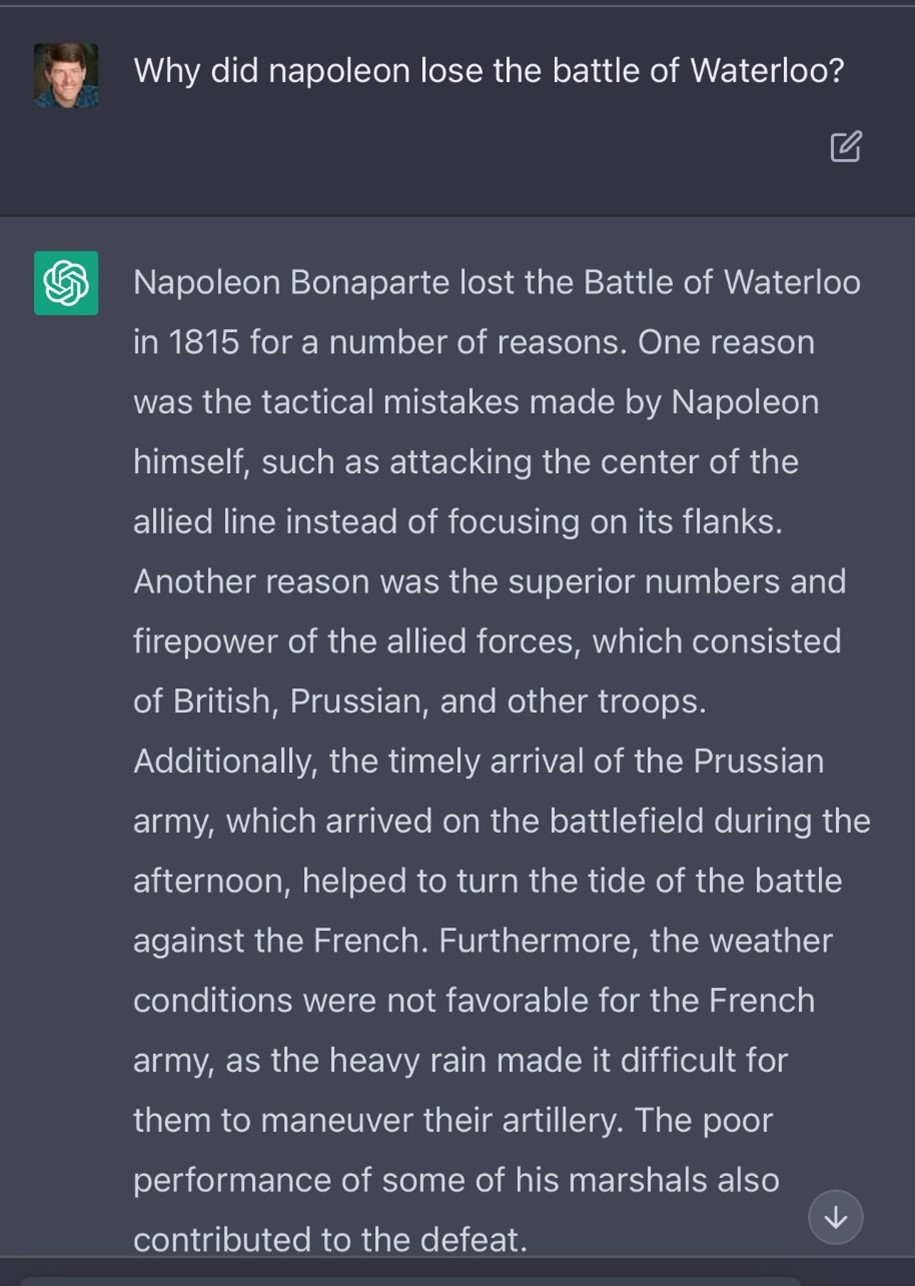
As you can see chatGPT formulates text responses that contain relevant information, are very readable, and flow well.
You can also ask follow on questions related to previous answers much like you would during a conversation with a friend.
In the case above I asked the follow-on question: ‘How did the poor performance of the generals contribute to the loss?’ ChatGPT responded with a well written paragraph highlighting several issues Napoleon’s generals had including tactical errors they committed.
You can also ask chatGPT to tailor its answer in a particular writing style. Jason Smith summed it up this way ‘One interesting input you can give chatGPT is a persona to answer. At the end of your questions add “answer like Tony Robbins” or “like a best friend”’. This is another facet that makes chatGPT responses more human like.
Questions About Our Industry
I also asked it more technical questions closely related to our industry like “What is the best costing method for greenhouse growers?”
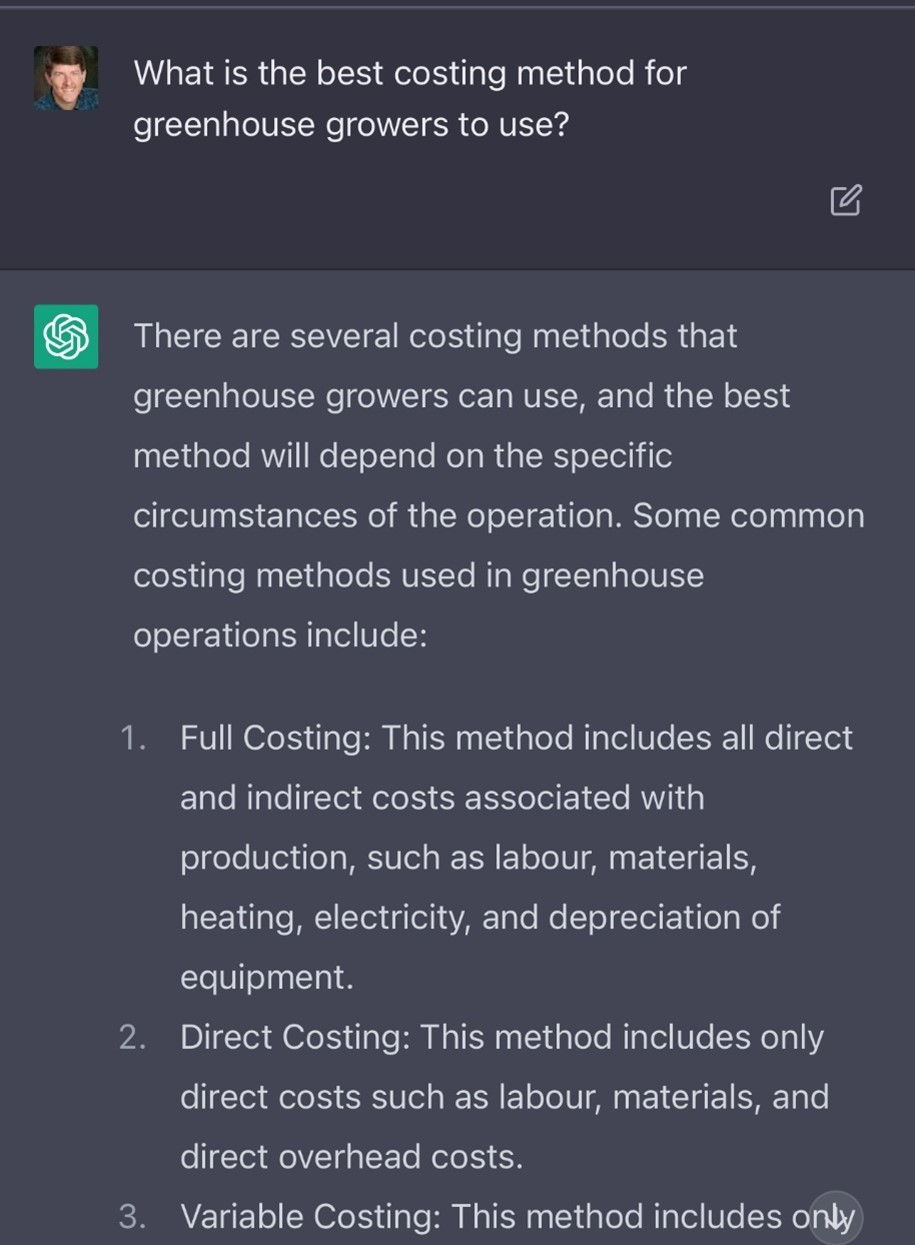

Certainly, the material it gives back in this case is at a high level, but you can continue to ask more clarifying questions to tease out more detail. And, like any good consultant, chatGPT issues the appropriate disclaimers and calls for involvement of experts in your area.
ChatGPT won’t be your CFO anytime soon, but it is impressive that chatGPT can articulate understandable, readable, and accurate answers to even complex scenarios that require information synthesis.
What Else Can chatGPT Do?
It can pass some law class exams.
It can pass United States Medical Licensing Examinations (USMLE).
It can pass a Wharton Business School MBA class exam.
It can write software code.
It can write poetry.
It can pass Amazon Engineering interview questions.
It can help you negotiate a raise.
And Google search results are replete with examples of chatGPT writing blogs, essays, and articles and doing other impressive linguistic feats.
Risks and Issues with chatGPT
The capability of chatGPT is impressive, but it comes with some risks and controversy.
Any supervised learning artificial intelligence model must be trained with a data set so the model can build the proper internal heuristics to identify the patterns it is being trained for.
- Risk: Possibility of incorrect or biased information: GPT-3 is no different and was trained ‘with data from CommonCrawl, WebText, Wikipedia, and a corpus of books.’ (https://towardsdatascience.com/gpt-3-a-complete-overview-190232eb25fd) This means that, just like Google reads and indexes web pages for search results, much of the data used to train GPT-3 was from the internet. And, as we all know, not everything on the internet is accurate, factual, unbiased content. OpenAI clearly acknowledges this in the opening screen of chatGPT when you login.
- Risk: Content moderation: Additionally, because the GPT-3 model used internet data for training purposes, objectionable, illegal, and harmful content were encountered and processed during the training phase and had to be filtered. Filtering is done using a content moderation process with the aid of human workers. OpenAI used a subcontractor, who also did work for Meta (Facebook), and there are on-going legal disputes over the treatment of workers who did the content moderation work.
- Risk: Educational impact due to cheating: Another area of controversy surrounding chatGPT is the use of chatGPT by students or researchers, who, lacking time or scruples, may use chatGPT to generate content for essay or other writing assignments, passing the generated text off as their own work, creating an ethical problem as well as a learning barrier. Further, some research institutions have also limited or banned the use of chatGPT as co-authors of scientific or research papers.
- This type of use of chatGPT prompted Edward Tian to write a software tool to try to detect text that was generated by artificial intelligence. Additionally, in response to educational worries about cheating with chatGPT, OpenAI itself has released a tool to attempt to detect AI-written text.
- Risk: Intellectual Property ownership and copyright infringement: If chatGPT, or similar artificial intelligence systems, do generate new and innovative ideas, literary works, algorithms, imagery, or similar intellectual property, who owns the intellectual property rights to the created work? This issue is already starting to play out in courts and could impact the way that the results of these technologies are used. For example, Stability AI Ltd. is named in a class action lawsuit over copyright from images that their tool, Diffusion AI, generated from other works on the internet.
So How Will chatGPT Help Growers?
ChatGPT is an amazing evolution of artificial intelligence research work that has been going on for decades surrounding natural language processing.
ChatGPT, like any cutting-edge technology, will take time to mature and produce demonstratable results for industry. Our industry adopts Software and IT technology more slowly than other industries as growers are cautious with their capital investments, not wanting to spend money on unproven technology with difficult-to-calculate returns. Artificial intelligence and machine learning are beginning to be used in our industry, but they are not yet adopted on a wide scale across the spectrum of growers.
A slow adoption curve and complex technology implementation, coupled with the current research state of chatGPT, mean I don’t see chatGPT being able to answer a grower’s question like “When will the pint pansies in Greenhouse #5 be ready to ship?” anytime soon.
However, if a version of chatGPT were trained with the written and video/photographic data we have regarding the crops grown and that technology was tied into a grower’s ERP software and data systems, this would present an integrated whole of the general horticultural knowledge with the specific situation of the grower’s operation. At that point, a world of possibilities opens for giving growers a much more human like interface to their operation. Think of something like J.A.R.V.I.S. for growers.
A version of the chatGPT like technology with access to the right sensors, grower ERP data and other external data details like the weather forecast and the sales analytics from the grower’s customers, could become the growers’ new query language to understand their operation faster, and at a deeper level and a smaller staff impact. This tool will replace an army of back-office workers generating Excel spreadsheets manually. And, if you add advanced predictive analytics and forecasting techniques to this new technology stack, a grower will have a superior capability to create and execute better plans, optimize profits, and improve replenishment performance. This capability would reduce back-office staff demands allowing them to focus on more crucial business improvement activities.
There are many potential applications for this technology to growers which Rob Ferguson, founder of Ferguson Alliance and business advisor to several large growers among many clients said, “I can see many future applications on how this could be a great assistant to growers, real time, in the field doing diagnostics on crop culture, costs, location, etc. As with all machines, good data in gives good information out. Bad data….”
The Next Wave of Business Automation
No doubt advanced software technologies like chatGPT will be part of the next wave of software improvements and become standard business practice, even for growers, in the next few years.
This is how Fast Company describes the next wave of automation for business:
Research by PwC states that the next automation wave will address repeatable tasks and the exchange of information (as in financial data analysis) that will be done by humans and automated systems working together. Doing this means we must increase our data management and processing capabilities, as AI-driven automation can process complex data sets much faster than people are capable of handling, leaving the available workforce with time for more important tasks.
This description sounds a lot like what many grower employees do all the time, that is processing large, complex data sets to support decision making.
I believe technology like chatGPT will be a key part of that next wave of business automation for growers.
I think it fitting to end the section on ‘How will chatGPT benefit growers’ by asking chatGPT itself.

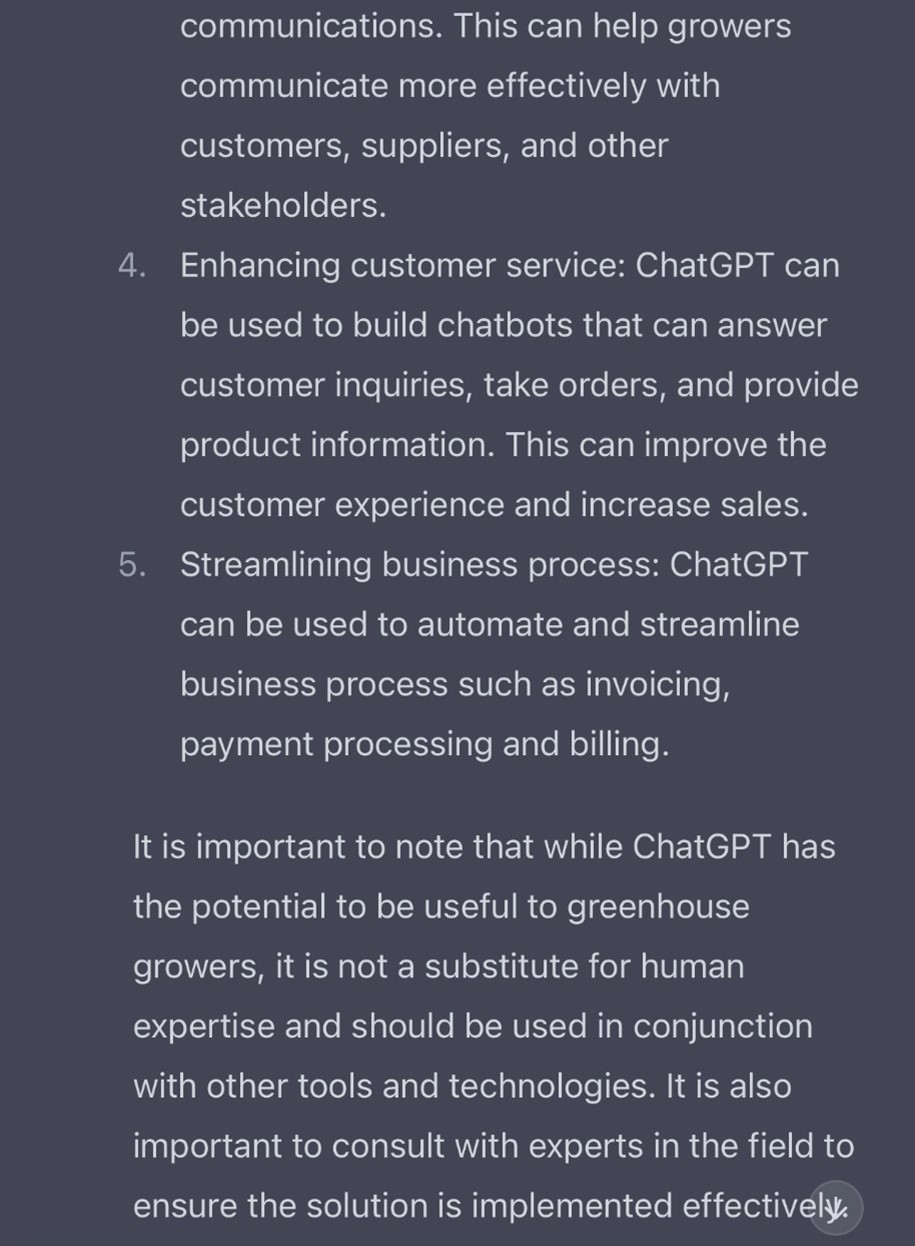
You can try chatGPT for yourself by creating an account at https://chat.openai.com/auth/login. But be aware, there are lots of folks trying it now and the free tier does have capacity limits so you may get a message that the server is too busy.






